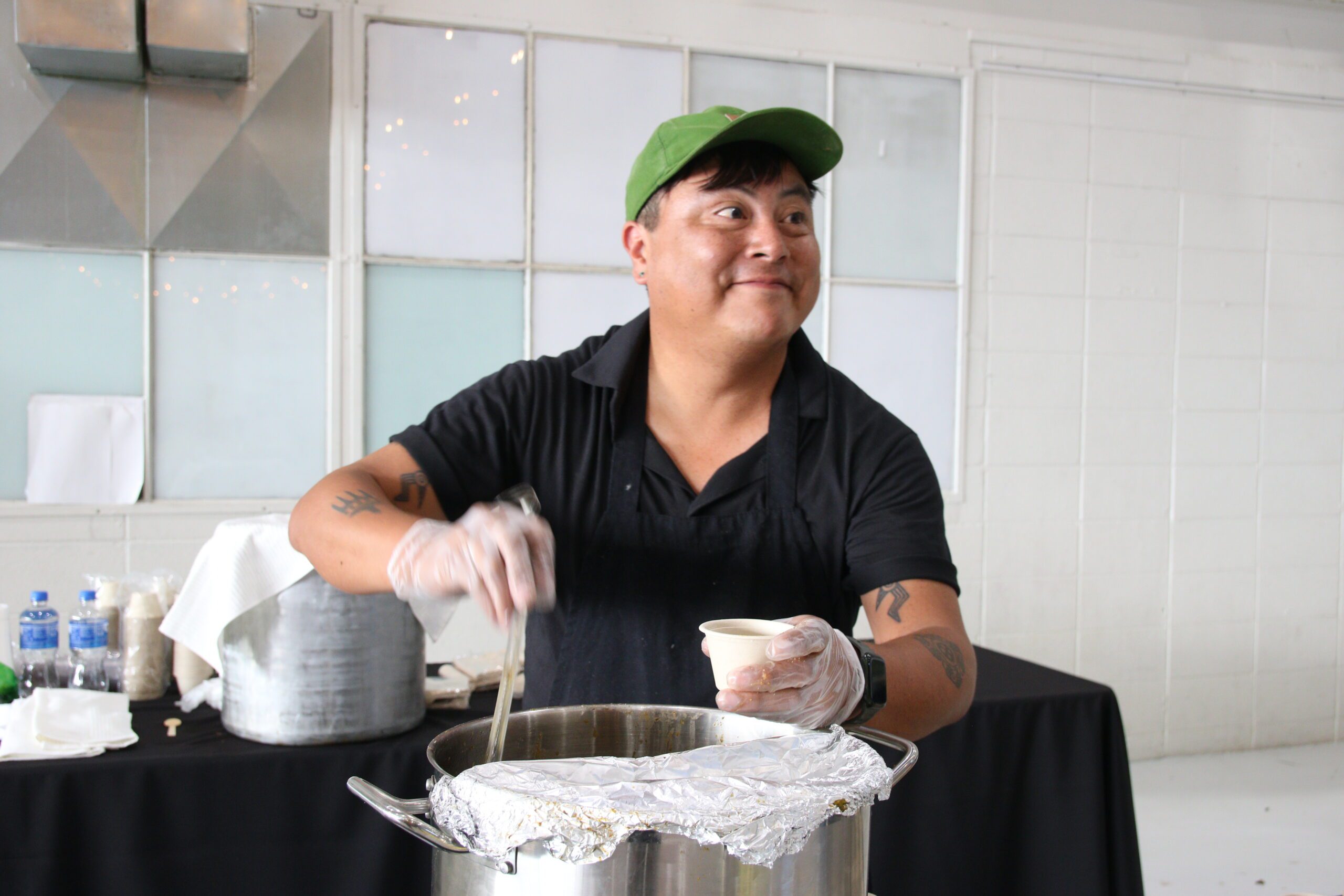“I sourced domestically and Indigenously to assist these economies,” she stated.
Chef Andrea Murdoch is busy within the kitchen of the Identical Café in Denver — a pay-what-you-can restaurant run fully by volunteers. She generally makes use of the kitchen house when she wants an additional oven or two.
“All the pieces is a mix of Russian roulette and a Rubik’s dice in kitchens,” she stated to a volunteer chef, laughing.
As volunteers take out pans and rip off items of parchment paper to cowl them, a candy odor wafts from the ovens. Murdoch is baking her well-known mild blue sugar cookies for an Indigenous Comedian-Con occasion later that week.
“They appear good, and so they odor good too!” stated one volunteer chef.
“And it helps Indigenous economies!” Murdoch yelled again.
However Murdoch — one of many Indigenous cooks that’s a part of a brand new wave of Indigenous delicacies in Colorado and different components of the Mountain West — doesn’t make cookies like different cooks. As a substitute of utilizing flour, she’s using Ute Mountain Ute cornmeal present in Southwest Colorado.
“Blue cornmeal is one thing that is very particular to the 4 Corners area of the U.S.,” she stated. “You’ll not discover this simply out on the West Coast, out on the East Coast.”
And this isn’t the primary time she’s used distinctive elements in her cooking to assist and spotlight Indigenous meals sources.
“I sourced domestically and Indigenously to assist these economies,” she stated. “Kroger would not want my cash.”
Going again to her origins
Murdoch’s story is kind of the journey, born out of the connection to her tradition. She was born an orphan in Caracas, Venezuela, close to the Andes Mountains. She was adopted shortly after and got here to the USA. She grew up cooking along with her household and shortly went to culinary faculty in New York.
Regardless of the assorted locations she cooked and traveled, she has at all times been impacted by the ladies of Oneida Nation — only some hours from Milwaukee. They shared their creation story along with her in addition to easy methods to make their model of cornbread.
“It unlocked one thing in me the place I simply felt at residence,” Murdoch stated. “…Having that type of cultural expertise and mindset, that felt like a reconnection.”
Quickly after, Murdoch needed to develop 4 Instructions Delicacies — her meals enterprise — and create South American delicacies. Via her analysis, the Andinan chef discovered the elements that had been consultant of the tradition had been pre-colonial. That refers to any meals that existed in America earlier than colonizers arrived, like rabbit or bison.
“I used to be tapping in increasingly to my ancestry, whether or not I knew it or not,” Murdoch stated.
She needed to “return to her origins” in her cooking and assist Indigenous communities. Her elements come from Indigenous or native farmers, like Miller Farms and Strohauer Farms. She chooses elements throughout the state as a lot as potential and does what her ancestors did — reside off the land.
“[I] make the most of what’s there,” she stated. “We did not have this, ‘Oh yeah, simply ship it from wherever you might be.’”
She additionally taught herself easy methods to forage on her personal for elements. She shared how she’s going to take her canine and exit by herself as her “quiet time”, searching for flowers or spruce suggestions for her dishes.
“I particularly adore it when it is raining and I am on the market foraging as a result of I will discuss particularly to Illapa, our climate god, as a result of that rain is a present that’s going to assist our crops,” she stated. “It may assist the land, it helps all of the issues. It is a part of the system that makes all the pieces go spherical.”
She is going to ceaselessly discuss to the gods and her ancestors whereas she cooks. Murdoch lays out all of the elements in entrance of her and simply begins cooking, tapping into what she calls her “sixth sense.”
“I do not at all times method cooking and creating menus the way in which most cooks method it,” she stated. “There’s a component of listening to the elements and understanding how you are going to honor them greatest.”
Whereas she doesn’t personal a brick-and-mortar restaurant but, she cooks for numerous occasions by 4 Instructions Delicacies — something from a mirco-wedding, to cooking courses to a small chef’s desk. She loves serving smaller teams as a result of there’s extra room for “whimsy.”
“[I’ll] say, ‘Hey, if it is OK with everyone, I’ve these pickled spruce suggestions that I believe go actually, actually properly on high of your elk meat taco,” she stated. “And everyone simply type of appears round like, ‘Yeah, we’re sport.’ After which that turns into a garnish and it additionally turns into a dialog piece and I get to speak to them about how I went foraging [and how] the buds are solely on the market for a restricted time earlier than they do totally sprout.”
Murdoch stated it’s rewarding to observe Indigenous folks reconnect to their ancestral meals — in addition to watching folks attempt new elements for the primary time.
“To see that satisfaction on their face, I am similar to, ‘Sure, sure,’” she stated. “That is what information change and cultural change particularly is all about.”
She hopes those that eat her meals take away the deeper information of the place it comes from and its ties to tradition.
“The way in which I take a look at meals is respect,” she stated. “It goes again to the Indigenous tradition that vegetation aren’t simply vegetation, they’re plant relations.”
Native delicacies: changing into common, but nonetheless hidden
This sort of Indigenous cooking has grown in recognition, with many eating places opening for the reason that pandemic in large cities comparable to Minneapolis and Seattle. Some Indigenous cooks are additionally increasing on the earth of cookbooks. And, for the second 12 months in a row, an Indigenous chef gained a James Beard award. The James Beard is sort of just like the Oscars for cooking.
Murdoch stated Indigenous creatives like these have at all times existed, however they had been in restricted areas. She’s excited to lastly see their work within the highlight.
“For those who had instructed me 5 years in the past that that is what the Indigenous meals panorama was going to seem like on this nation, that we had been going to have extra eating places being open, that individuals had been going to say sure and greenlight Indigenous primarily based tasks, I most likely would have checked out you with a lot skepticism,” she stated.
Nevertheless it wasn’t at all times this fashion, and in some circumstances, it’s nonetheless invisible to the general public. Many individuals can’t title even one Native restaurant, and Google typically lumps the restaurant class “Native American” with “Indian” or different ethnic eating places.
“Even pho, Thai delicacies, like, I can discover these eating places a hundredfold earlier than I discover an Indigenous delicacies primarily based restaurant,” Murdoch stated. “And we reside on the continent of North America.”
Many different Indigenous cooks really feel this fashion. Sean Sherman, the top chef of Owamni in Minnesota and winner of a number of James Beard awards, stated many individuals draw an enormous query mark on the subject of figuring out Indigenous dishes.
“We must always actually be centered on what is the true meals of North America,” he stated. “And you may’t perceive North American meals until you convey the Indigenous perspective into it.”
He spoke in a TEDTalk about how the absence of Native eating places has to do with historical past. Bison had been killed at alarming charges. Indian boarding colleges and compelled assimilation stripped them of their tradition. And pushing Indigenous folks onto resource-poor reservations with none land rights put them in a systemic entice.
“We simply went by a extremely traumatic time in historical past the place we have not had time to heal but, not to mention evolve,” he stated. “… The extra you dig into it, the extra inequality you see and the extra racist buildings you could see which can be nonetheless constructed into the system.”
Sherman is hopeful concerning the Indigenous meals producers, cooks and meals vehicles which can be coming onto the scene, however he stated there’s room for extra — in addition to extra room for understanding.
“There’s simply plenty of work to do and there is plenty of minds to alter. However we’re doing it by one thing very constructive, which is meals.”
That’s precisely what Murdoch needs to spotlight. The work she does for 4 Instructions Delicacies is not only catering — she’s hosted fundraising dinners to convey consciousness to Lacking and Murdered Indigenous Family members, with proceeds going to the Nationwide Indigenous Ladies’s Useful resource Heart. She additionally wrote a ebook on Indian boarding faculty trauma, with a proportion of the gross sales going to the Nationwide Native American Boarding Faculty Therapeutic Coalition.
“Sure, I am a chef, however I am utilizing that platform to convey consciousness to cultural points,” she stated.
Feeding past meals
One latest occasion Murdoch helped with was Denver EATSS, or the Epicurean Award To Help Students occasion, in June. Hosted by the American Indian Faculty Fund, it raises tens of tens of millions of {dollars} every year for college kids to attend one of many 35 tribal faculties and universities within the nation, together with colleges in Arizona and New Mexico within the Mountain West.
“Gaining access to faculty expertise is a common problem, however it’s extra so I believe, in Indigenous communities the place there’s loads much less entry to financial sources, there’s loads much less bodily entry to locations to go to varsity,” stated Cheryl Loopy Bull, a Sicangu Lakota and Rosebud Sioux girl, and the Faculty Fund’s CEO. “We discover if we take away these boundaries, then we enhance Native scholar participation.”
The dinner portion of the occasion sheds mild on some frequent meals that had been pre-colonial and the way Indigenous folks have used these meals for hundreds of years.
The Indigenous cooks ready a wide range of dishes. Murdoch made a swirl cake utilizing elements like popped amaranth, strawberry sauce, edible flowers and the identical cornmeal from her sugar cookies. Chef Bradley Dry of the Cherokee Nation in Oklahoma made a Hen of the Woods Mushroom soup with roasted blue cornmeal and onions.
“[It’s] my homage to my household, as a result of … I grew up foraging mushrooms with my household,” Dry stated. “That is type of a mix of all the pieces I ate as a child in a soup type.”
The primary meals for the occasion was catered by Tocabe American Indian Eatery in Denver. Ben Jacobs, the eatery’s co-founder and a member of the Osage Nation, did variations on conventional dishes, like blue corn mush, Osage Hominy relish, and Three Sisters.
“We name {that a} ‘Three Sisters, One Chew’ as a result of all three sisters — corn, beans and squash — are multi functional chew,” he stated, pointing to the dish on the desk. “We’ve a blue corn chip, white bean purée, butternut squash, New Mexican crimson chili, amaranth, microgreens, smoke, and salt.”
Jacobs shared how his love for cooking was impressed by his mother and father who opened up a small Native restaurant in Denver in 1989 for the Indigenous neighborhood. About 20 years later, Jacobs and his co-founding companion, Matt Chandra, opened Tocabe’s first location. His purpose with the restaurant was to make Native delicacies accessible and present others what Native folks contribute to the culinary scene.
“[We] needed to create one thing that wasn’t simply at all times for a neighborhood occasion,” he stated. “We needed to create that for our folks, for our neighborhood, but in addition as a solution to share id and tradition and who we’re and the place we’re going.”
Since then, certainly one of Tocabe’s brick-and-mortar areas has shut down and reconverted right into a Native ingredient achievement middle that plans to distribute meals to tribal communities. Jacobs stated for the reason that starting, his work has at all times been about supporting the neighborhood — not a revenue margin.
“The purpose is with the ability to present folks with meals that is significant and never fear about, on the finish of the day, mak[ing] cash,” he added. “We’re right here to make impression.”
Murdoch needs to do the identical. She hopes that by cooking at occasions like this, she will uplift the delicacies and causes of her neighborhood whereas inviting others into the invention.
This story was produced by the Mountain West Information Bureau, a collaboration between Wyoming Public Media, Nevada Public Radio, Boise State Public Radio in Idaho, KUNR in Nevada, KUNC in Colorado and KANW in New Mexico, with assist from affiliate stations throughout the area. Funding for the Mountain West Information Bureau is offered partially by the Company for Public Broadcasting.










